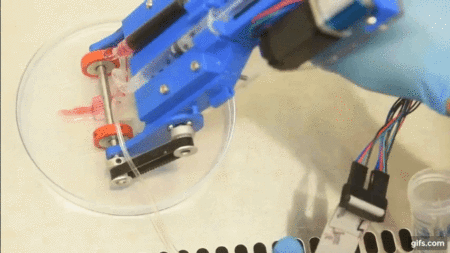February 6, 2020 – Canadian scientists from the University of Toronto and the Sunnybrook Research Institute have invented a portable bioprinter capable of printing skin cells to treat wounds on burn victims. When positioned above a target surface area, it deposits skin tissue that is generated by a microfluidic cartridge.
This invention represents a rapid departure from the current standard of care for patients with severe large-area burns. The standard practice involves autologous skin grafts or acellular substitutes and is fraught with challenges, particularly susceptibility to infection. And any existing bioprinters are not portable, but rather are bulky, expensive and slow. That’s not the case for this new handheld instrument that delivers mesenchymal stem cells contained in fibrin sheets directly to a wound surface along with bio-neutral polymers and proteins to evenly distribute cell layers. The end result, improved surface skin, and epidermal regeneration. A paper describing the invention appears in the February 4, 2020 edition of the journal Biofabrication.
Burns are a global public health problem, according to the World Health Organization, accounting for an estimated 180,000 deaths annually with most occurring in poorer countries. And while burn death rates are declining in rich countries, the rate of child deaths from burns in the Developing World is seven times higher than in the Developed World. In 2004, almost 11 million people globally suffered from burns severe enough to require medical attention.
The inspiration behind the invention of the portable bioprinter was seen by the University of Toronto and Sunnybrook team, to be the need to address a lack of expertise and facilities to deal with burns in the Developing World.
Where surgically transplanted skin grafts require a significant amount of healthy donor skin to be applied in deep wounds to all three layers of the skin, the epidermis, dermis, and hypodermis, availability is often not there.
But the handheld bioprinter with minimal training can deposit epidermal and dermal tissue along with a mixture of bio-neutral polymers and proteins for even distribution of the cells layers. The printer also delivers hyaluronate, a protein that is contained in hyaluronic acid to promote healing and skin cell integrity. The combination contained within the bioink in mouse and pig studies showed effective repair results of burn wounds. It soon may be available for human trials and become a new standard in dealing with deep-wound burns, potentially replacing skin grafting processes.









